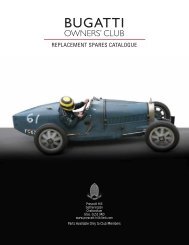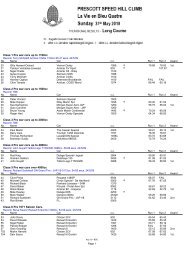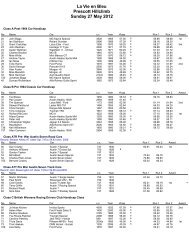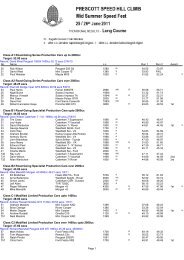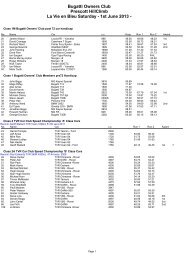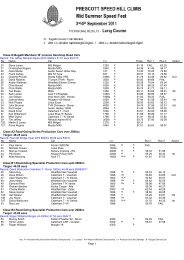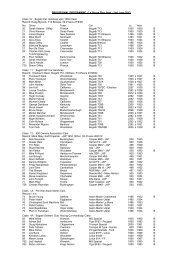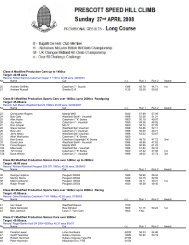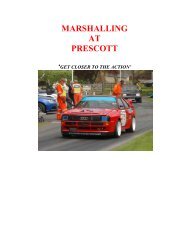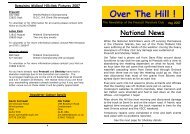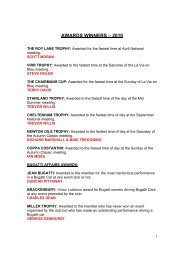BUGATTI OWNERS CLUB - Prescott Speed Hill Climb
BUGATTI OWNERS CLUB - Prescott Speed Hill Climb
BUGATTI OWNERS CLUB - Prescott Speed Hill Climb
Create successful ePaper yourself
Turn your PDF publications into a flip-book with our unique Google optimized e-Paper software.
<strong>BUGATTI</strong> <strong>OWNERS</strong> <strong>CLUB</strong><br />
The Bugatti Owners’ Club has prepared these notes in order to answer queries which are received from<br />
time to time from those contemplating a first time entry into the sport of <strong>Speed</strong> <strong>Hill</strong>climbing. These notes<br />
are intended as a guide only and the Club cannot accept responsibility for any particular interpretation<br />
which individuals may place upon them. It should be understood that the regulations issued by the MSA<br />
can be varied from year to year so any reference made to such regulations in these notes are subject to<br />
variation without notice being given by the Bugatti Owners’ Club.<br />
NOTES FOR NOVICE HILLCLIMB COMPETITORS<br />
HILLCLIMBS IN GENERAL<br />
There are many hillclimb venues throughout the country and a list of these is included on the MSA<br />
website, please visit www.msauk.org It is suggested that, as a first step, you should select an event and go<br />
along as a spectator to see what happens. Next you should determine which of the MSA recognised Clubs<br />
is likely to suit you best. Most of these Clubs run a Competitions Section and the Competitions Secretary<br />
of the Club which you choose is the person best able to help you with any queries which you may have.<br />
You may also decide to attend one of the <strong>Hill</strong>climb Schools operating under the supervision of AHASS, the<br />
Association of <strong>Hill</strong>climb and Sprint Schools. Details of these can be obtained by telephone to the Drivers<br />
School Secretary on 01242 679796 or by fax to 01242 677001. These Schools are open to all, no special<br />
qualification is needed, the only stipulation being that the car which you enter must comply with current<br />
MOT regulations and that you hold a valid Drivers Licence. This forms an excellent and practical way of<br />
taking the first step into the sport and is highly recommended. Attendance at a School will enable you to<br />
find out about all the many aspects of hillclimbing. At this stage there is no need for you to apply for a<br />
competition licence but this will become necessary if you subsequently decide to take part in any<br />
competitive event. The procedure for this is given in the paragraph “Entry Procedures” below.<br />
ELIGIBILITY OF CARS<br />
In broad terms any car licensed for use on the public highway can be entered for a competitive hillclimb<br />
event, although certain restrictions will apply in respect of cars covered by the MSA definitions of Sports<br />
Libre and Racing Cars. Reference is made below to the Competitors Yearbook, which is issued, with all<br />
Competition Licences and this publication will give full details of eligibility for all the several classes into<br />
which cars are divided. As a guide the Bugatti Owners’ Club publishes a representative list of classes for<br />
<strong>Prescott</strong> <strong>Hill</strong>climb events is attached to these notes.<br />
ENTRY PROCEDURE<br />
Before seeking an entry in <strong>Speed</strong> <strong>Hill</strong>climb Competitive Event it is necessary for the Driver to be a<br />
member of an MSA recognised Motor Club. If not already a member of such a Club, it is helpful to select<br />
one that promotes its own <strong>Hill</strong>climb or Sprint events as not all of the smaller clubs receive invitations to<br />
these events. An MSA Competition Licence is also necessary. This is obtained by application to MSA<br />
Ltd, Competition Licence Department, Motor Sports House, Riverside Park, Colnbrook, Slough, SL3 0HG.<br />
You should apply for a Non-race National Grade ‘B’ licence which entitles you to enter an eligible vehicle<br />
in Clubmans or National ‘B’ events. With your licence you will receive a copy of the annually published<br />
MSA Competitors Year Book (the ‘Blue Book’) which gives full details of all regulations. It is suggested<br />
that particular attention be paid to car eligibility rules relating to the Grade ‘B’ licence holders.<br />
Entry Forms and Supplementary Regulations relating to particular events are obtained by applying to the<br />
promoting Club.<br />
If your entry is accepted you will receive an acknowledgement from the Club together with Final<br />
Instructions, entrance tickets and any other relevant paperwork. Please be aware that most events are a one
day event. However, <strong>Prescott</strong> and other National events are also held over two days, practice one day and<br />
competition runs the next day. You need to be present on both days.<br />
GRADING OF LICENCES<br />
A Non-race National ‘B’ licence can be upgraded to <strong>Speed</strong> National ‘A’ after the licensee has obtained the<br />
signature of the Clerk of the Course at four Clubmans or National ‘B’ events, during a period of two years.<br />
These signatures acknowledge that a level of ability, satisfactory for experienced drivers, has been shown.<br />
One attendance at a School approved by AHASS will count as one signature subject to the applicant<br />
passing a brief examination and being satisfactorily assessed by a Registered Instructor at the School.<br />
PREPARATION OF THE CAR<br />
It is your responsibility to ensure that your vehicle is in fully serviceable condition. It is equally your<br />
responsibility to ensure that it complies in every respect with the MSA Regulations applicable to the Class,<br />
which you intend to enter. An MSA Scrutineer will inspect your car on the day of practice before the event<br />
and will only be allowed to run if it complies with the regulations. There may also be a separate test for<br />
noise. Road cars with normal exhaust systems are unlikely to fail this test but if your car is fitted with a<br />
non standard system this should be checked. The onus is upon you to comply with the noise regulations.<br />
As a general guide the maximum permitted noise levels at <strong>Hill</strong>climb venues, measured at 0.5m and at a 45<br />
degrees from, the exhaust outlet, at an engine speed of 2/3rds of maximum revs, is 110 dB(A). Make sure<br />
the car is clean, that tyres are in a satisfactory condition, only those tyres included in list 1A of MSA GR R<br />
3.1.1. are permitted in the road going classes. Racing tyres must be in a condition considered safe by the<br />
Scrutineer.<br />
You will need a timing strut fitted to the front of the car. This must be of solid material, matt black finish,<br />
254mm high x 51mm wide, mounted clear of any sideways obstruction and positioned so that the bottom is<br />
not more than 200mm from the ground and the top not less than 454mm from the ground. You are advised<br />
to obtain suitable competition numbers before the event, as these are not always available on the day.<br />
Advertising is permitted on the car provided that it does not interfere with the identification of the<br />
competition number, is not offensive and if it is on transparent material the depth of the display must not be<br />
more than 50cm. There are various aspects of Regulations applicable to different classes, too numerous to<br />
mention here, so reference to the ‘Blue Book’ is advised, also fellow competitors are usually willing to<br />
help with advice.<br />
LOG BOOKS<br />
An MSA Log book is required if you are competing in a car other than one registered for the road and<br />
competing in the event in road legal condition. A Log Book will be needed if the car has an engine of<br />
greater capacity than that with which it was originally constructed or if the engine has been since equipped<br />
with forced induction.<br />
ARRIVAL AT THE EVENT, SIGNING ON AND PREPARING FOR PRACTICE<br />
Try to arrive early enough to enable you to have adequate time to walk the course. First locate the space in<br />
the paddock which has been allotted your number. Park your car there and before unloading, report to the<br />
paddock office, taking with you your Competition Licence and Club Membership Card.<br />
You will be asked to ‘sign on’ and you will be given a programme and a card for initialling by the<br />
Scrutineer after he has inspected your car.<br />
Find out if there is there is enough time for you to walk the course, and if so, do so at once. (The alternative<br />
to this is to arrive well before the paddock office opens, this will give you ample time to walk the course at<br />
your leisure). Return to you car and remove everything which is not required while competing. Make sure<br />
there are no loose items in the cabin/cockpit area, that the timing strut is correctly fitted, tyre pressures<br />
checked, fuel, oil and water levels correct, spare wheel removed, and competition numbers in place on the<br />
sides of the car. At some events extra numbers on the front of the car may also be needed. Depending on<br />
the venue you may find that the Scrutineer comes to you or it may be necessary for you to locate a member
of his team. In any case your neighbouring competitors can often tell you what the situation is. When the<br />
Scrutineer comes to your car open any covers to engine and other compartments and be helpful with any<br />
information you may be asked to give. It is not necessary to have the car raised on jacks unless specifically<br />
requested by the Scrutineer. As well as the car and its equipment, he will inspect your overalls, helmet and<br />
seat belts, all of which must comply with current MSA Regulations. With everything passed he will initial<br />
the card which you were given when ‘signing on’ and give you an official sticker for you to place in a<br />
visible position in the car.<br />
You should then return to the Paddock Office, show the initialled Scrutineer Card and ask for an allocation<br />
of Practice times. This may be done verbally or by means of a ticket. (This is the <strong>Prescott</strong> procedure but at<br />
other venues there may be some alteration, so ask when you sign on). Return to your car and make a<br />
further check that all is ready to go. Stay with, or near, your car and await instructions which will be given<br />
either over the public address system or by a paddock marshal indicating that you should be ready to be<br />
called forward to the start. When you are in the queue waiting to move up to the startline, put on your<br />
helmet and fasten your seat belt. If you are in a closed car, close the windows but do not lock the doors.<br />
Do not attempt to warm up tyres by spinning the wheels anywhere except in the designated area<br />
immediately before the start line, usually immediately after a yellow line across the track. When you arrive<br />
at the line, position the car as instructed by the startline Marshal, check that you are in the correct gear and<br />
wait for the green light to show.<br />
You do not have to start immediately the light shows, so pause while you get the engine speed correct.<br />
Then Start. Use your first run to assess approach speeds, gear change points, braking points, cornering<br />
speeds and as soon as the run has finished and you are back in the paddock sit in the car with a plan of the<br />
course in front of you and, while the memory of your first run is fresh in your mind, analyse your<br />
performance. Mark the plan where you consider you went wrong.<br />
Times will be shown on a time board, which is normally located in the paddock.<br />
You will have at least one more practice run and then two competitive runs in the event, so continue to<br />
analyse all these carefully and aim to achieve a progressive improvement.<br />
FALSE STARTS<br />
If you make a false start, provided that the rear wheels have not crossed the start line a re-start is permitted.<br />
SUBSEQUENT RUNS<br />
For your second practice run and the runs in the event the procedure is just the same as before except that<br />
for practice you may have been called forward in practice time order whereas for the competitive runs this<br />
will be strictly in programme order. You will be expected to be ready just as soon as you are called, if not<br />
you could have to forego your run.<br />
RESULTS<br />
Some Clubs will have printed results ready very soon after the end of the meeting. If you have time, it is<br />
helpful to wait for these, as they will give you the chance to compare your performance with the rest of<br />
your class. Results are normally available on the promoting clubs website within a day or two. At some<br />
venues there is a prize giving ceremony at the end of the day and drivers always appreciate a good<br />
attendance by their fellow competitors on these occasions.<br />
NB. Remember that if you are driving home in the car you have competed in it is important to remove<br />
competition number before you leave.<br />
INSURANCE<br />
Your entry fee provides cover for you against third party legal liability while competing and limited<br />
personal accident insurance as detailed in Appendix W 2.2 of the MSA Year Book.
SAFETY PRECAUTIONS<br />
Throughout an event or an attendance at a School you will be expected to take all reasonable precautions to<br />
ensure the safety of yourself and all others concerned. Re-fuelling should be done with care. If a fuel leak<br />
should become apparent this must be attended to effectively before running your engine. Smoking in the<br />
paddock can be a danger to all. Do not attempt to work under your car without proper support for the car,<br />
the ground can sometimes be soft and uneven.<br />
Paddocks are often congested places and manoeuvring cars can be difficult. You will not be popular with<br />
your fellow competitors if you behave carelessly.<br />
In the unlikely event of your car catching fire while on the track, stop and get out immediately.<br />
We hope that these notes will have helped to give you some understanding of what is involved in the<br />
sport of <strong>Hill</strong>climbing. We shall be happy to have the opportunity of welcoming you in due course<br />
either to the <strong>Prescott</strong> <strong>Hill</strong>climb Drivers School or as an entrant to a <strong>Prescott</strong> Competitive Event.<br />
If you still have unanswered queries please do not hesitate to ring the number below:<br />
The Bugatti Owners’ Club Ltd., <strong>Prescott</strong> <strong>Hill</strong>, Gotherington,<br />
Cheltenham, Gloucestershire, GL52 9RD.<br />
Telephone 01242 673136/679796.<br />
Fax 01242 677001.<br />
Email club@bugatti.co.uk<br />
www.prescott-hillclimb.com<br />
A Modified Production Cars up to 1400cc<br />
B(i) Modified Production Sports Cars over 1400cc up to 2000cc -Roadgoing (see note 1)<br />
B(ii) Modified Production Saloon Cars over 1400cc up to 2000cc<br />
B(iii) Modified Production Sports Cars over 1400cc up to 2000cc (Racing)<br />
C(i) Modified Production Saloon Cars over 2000cc<br />
C(ii) Modified Production Sports Cars over 2000cc<br />
D <strong>Hill</strong> <strong>Climb</strong> Super Sports Cars<br />
F Sports Libre Cars up to 2000cc<br />
G Sports Libre Cars over 2000cc<br />
H Racing Cars up to 600cc<br />
I Racing Cars over 600cc up to 1100cc<br />
J Racing Cars over 1100cc up to 1600cc<br />
K Racing Cars over 1600cc up to 2000cc<br />
L Racing Cars over 2000cc<br />
M Racing Cars manufactured between 1972 and 1985 inclusive<br />
N(i) Classic Saloon Cars built up to and including 1971<br />
N(ii) Classic Sports Cars built up to and including 1971<br />
N(iii) Classic Racing and Sports Racing Cars built up to and including 1971<br />
O Bugatti Handicap



